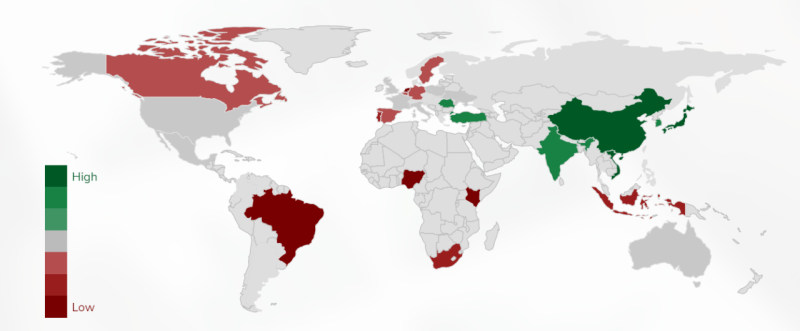7 Key Steps to Global Brand Management
Reading time: 7 minutes
With its intercultural dimensions Global Brand Management is not only one of the most fascinating parts of modern marketing but also one of the most complex parts. By breaking Global brand management into 7 comprehensive steps, you can build a framework to analyze and identify where you can improve the process of international brand management and increase your international marketing effectivity and brand equity.
1. Separating the universal truths from the culture-specific context
In most cases at least part of how the product is used by the customer is the same regardless of who uses it and where in the world that person uses it. For instance, think of banking products, sports shoes or apps on your phone. These will all be used similarly across the world, regardless of culture. Therefore it is easiest to build your centralized global marketing activities around these universal parts of the usage process. This can be done for example by communicating technical product attributes such as better cushioning or by communicating its practical product benefits like helping you prevent knee injuries.
The culture-specific context refers tohow the product is used and perceived in different cultural settings. This culture specific context often manifests itself in the tone of voice, product image or emotional brand attributes. For instance, if you look at the value “Glamorous”- you will see that its relative popularity differentiates strongly across different markets (figure 1). This can have a strong effect on your communication’s tone of voice for brands and products where a glamorous image plays an important role, think of fashion or spirits for example.

Figure 1: the relative value of Glamor across 27 different markets (Source: Glocalities; n=27,014; 2020).
2. Quantifying the culture-specific
To better understand the relevance of the culture-specific part of your brand and marketing, this part needs to be quantified. Quantifying the culture-specific makes it possible to not only determine in which manner markets differ from one another, but also to what extent they are similar. The latter is especially important as these similarities will help you navigate the trade-offs between a centralized, and therefore more efficient, marketing practice and a more local custom-made approach.
Knowing the similarities and differences will also help you set-up a more effective marketing organization to manage your brand and teams across markets and manage potential marketing conflicts that often arise between your central international marketing organization and your local marketing organizations. More on that in step 7.
3. Building target audiences across markets
Once you have quantified both the universal and the culture-specific part of your marketing activities, you can build target audiences across markets by focusing on the universal part of the marketing process.
The fact that there are social and cultural differences between countries is often acknowledged, however the social, cultural and lifestyle differences within a country less so. We have learned through experience that these social-cultural or lifestyle differences within a country are often just as large or even larger than the differences between countries. Fig 2. shows consumers’ attitudes towards focusing on healthy nutrients in food across three European markets. The visual also shows that, while there are important differences between these three markets, the differences between consumer groups within local markets are even more relevant.

Figure 2: Attitude of making effort to eat healthy between and within markets (Source: Glocalities; n=3117; France, Germany, UK; 2020).
Knowing this information can help you build target audiences across markets as there is a good chance that you will find similar target audiences in different markets. For instance, the ‘creatives’ mentioned in Figure 2 have similar attitudes and values in all three markets.
4. Assessing Local and International competition.
When building brands internationally, your competition and your market position can differ per market. You can be the strongest player in some markets while only being a challenger in others. In some markets your competition will be the “usual suspects” of large international brands, while in others it can be a set of strong and nimble brands that know how to play to local circumstances.
Each situation requires different marketing strategies and tactics. You should allow for flexibility in your overall marketing strategy and be able to influence the amount of (de)centralization of your brand in a particular market.
5. Building your Route-to-Market model
How you enter any given market is one of the main deciding factors that will determine your local market success. The choice of whether to build your own local marketing organization or consider working with a distributor matters. Often, the wrong type of distributor is chosen with insufficient marketing capabilities to build your brand or, alternatively, can’t get your product on the shelves.
Or you come to the slow realization that your distributor does not give your brand the attention it deserves because your sales are too small or he is planning to launch a competitive brand himself. Or perhaps that your distributor is too small to have any negotiating power and sales know-how to get you into the large retailers.
6. Activate local target audiences
Ideally, the head office marketing team travels to the local marketing organization in order to understand the market and prime target audiences. Together with the local marketing team, and based on local market research, you can then create a marketing plan tailored to the market in question. These local marketing visits are often skipped due to lack of time and resources. However, they more often than not bring a deeper and crucial understanding of the local market as well as the marketing and branding capabilities of the local team. These insights will be difficult to get from your desk at head office.
7. Managing brands and teams across markets
The pitfalls of this step are often overlooked. Cross-cultural differences can play a major role in misunderstandings and creeping mistrust within international marketing organizations. This is especially true when it comes to the cultural differences between the central (brand) marketing organization and the local (activation) marketing departments, as well as local sales teams, agencies or distributors. For instance, the famous Dutch bluntness is often emotionally experienced by the local teams as an underlying attitude of not being willing to understand, arrogance or even personal disrespect. Unfortunately, this disconnect can be very subtle and might take years to surface, if ever. This disconnect can manifest itself in the not sharing of all market information, which can prove fatal for your local brand success.
One large source of misunderstanding between the centralized (brand) team and the local marketing team is often to what extend the local market is different from the other markets. This is also where quantifying the culture-specific parts of your product plays an important organizational role as well. Once you have quantified these differences, it gives you an objective standard to openly discuss differences and similarities between your markets and what this means for your brand. (see step 2).
The act of sharing market information in itself is part of this management process. In many cultures, like in some Eastern European ex-communist countries, information is seen as a source of power that needs to be controlled, and will only be fully shared once a person, like the global marketing manager, has earned that trust. Trust in such environments is not given immediately as opposed to North Western Europe and the Anglo-Saxon world, where trust is first given and can be withdrawn after it has been broken. In many other cultures trust first needs to be earned before it is given.
Want to know more?
Reach out to Mash via the information down below.


